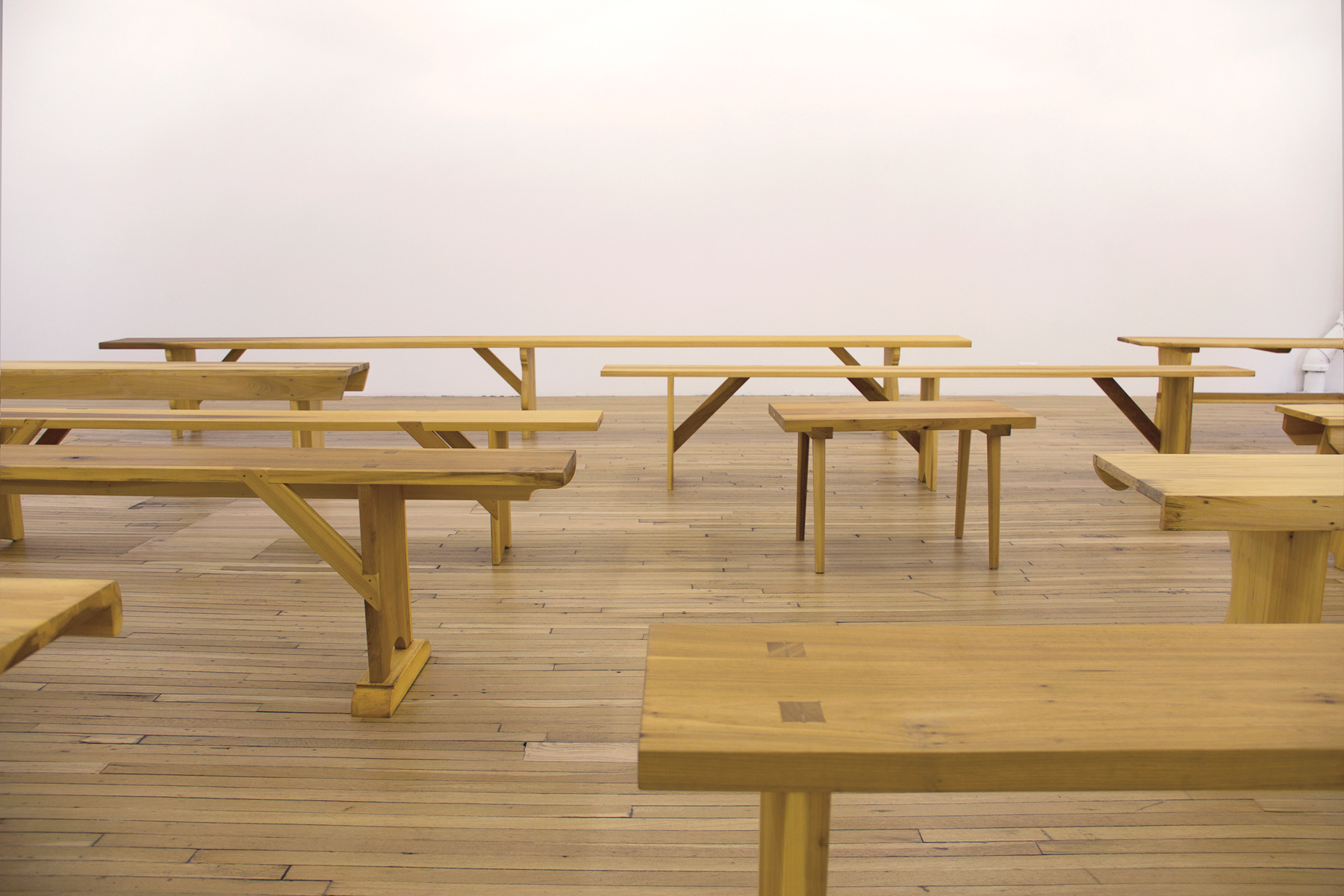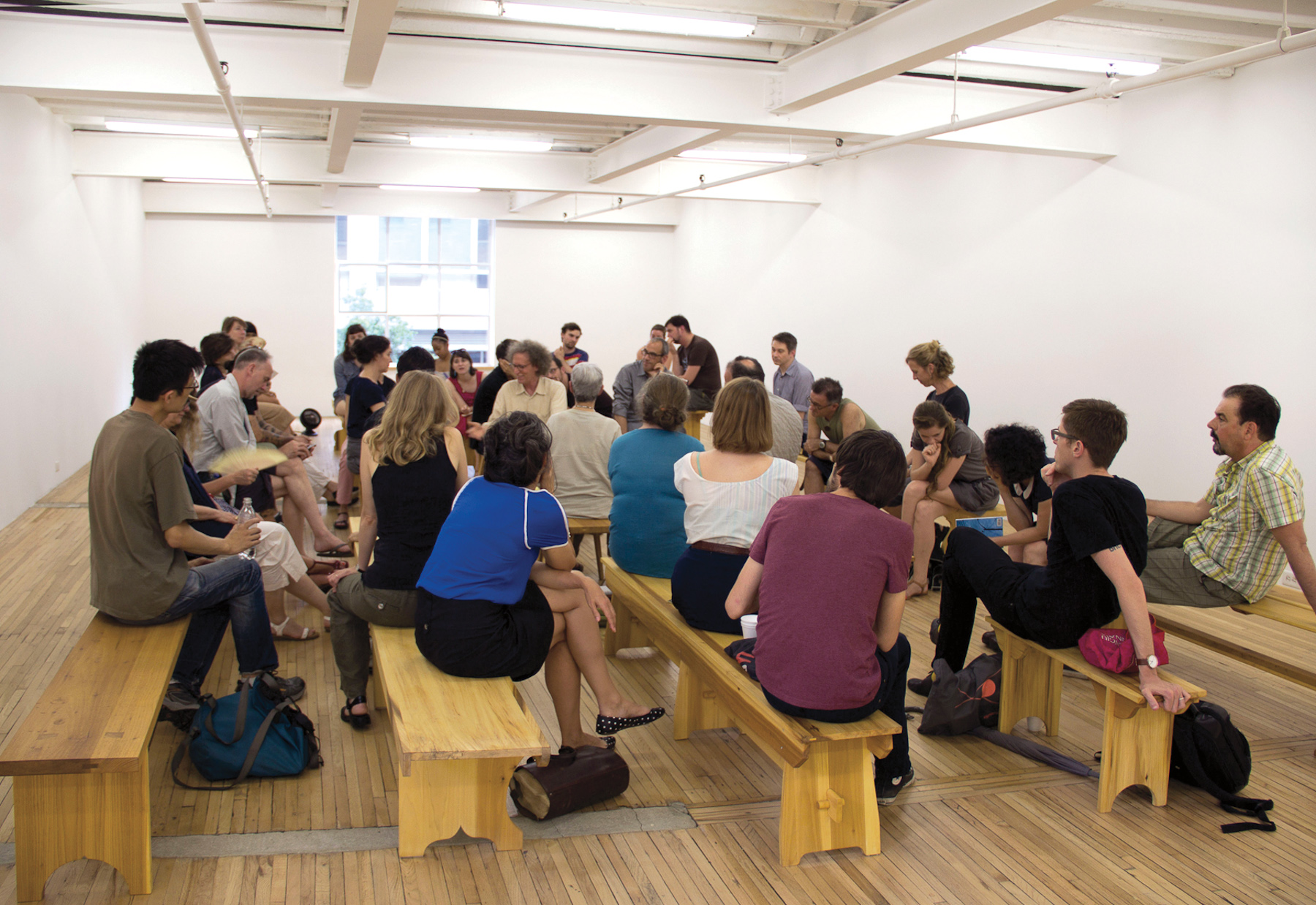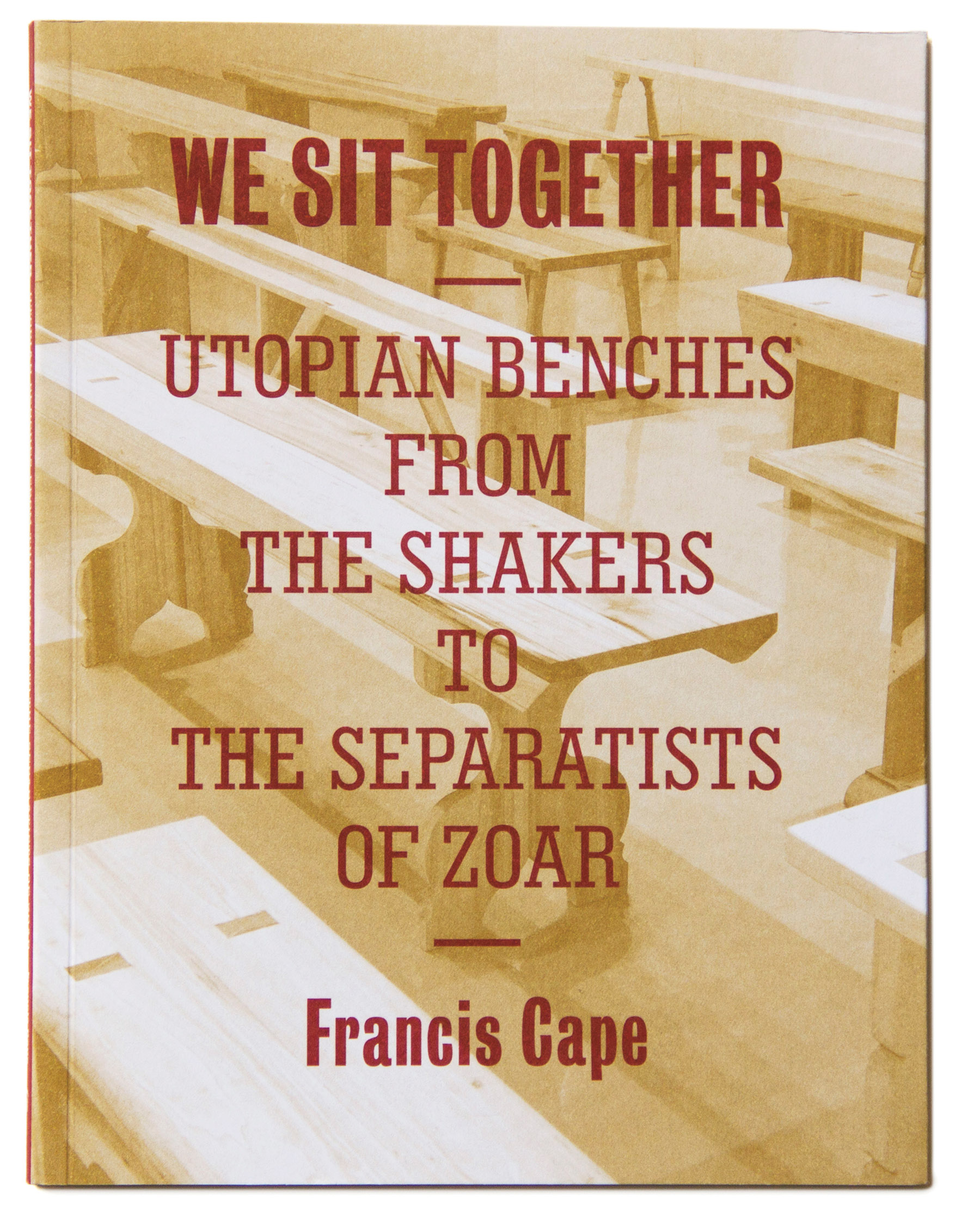Benches are for sitting. Francis Cape gets this. His Utopian Benches, recently shown at Murray Guy, is a collection of seventeen hand-finished poplar benches. The benches are replicas of congregational seating from various venerable American utopian communities.1 Both in form and in function, the benches attend to the needs of community, i.e. bringing people together. The manner of the benches is modest, as intended by their creators, but they remain spectacular pieces of pragmatic craftsmanship. There is little or no ornamentation—they are carved, sanded, and stained with restraint. The foundation upon which they sit is their own merit. In the gallery, the benches are arranged in clean rows, evoking sectarian sermons.
Taken as a whole, Utopian Benches forms one work, though the benches have been shown in smaller numbers. (Last year Cape showed a few of them at Franklin Street Works in Stamford, Connecticut.) The benches are a result of Cape’s research into these utopian communities, and he only made replicas of benches from which he was able to take direct measurements.

Francis Cape, Utopian Benches, 2011–12. Seventeen poplar benches, dimensions variable. Courtesy of Murray Guy.
Sculpture or craft, fundamentally they are benches, and as such the artist means for them to be sat upon. Cape’s artwork extends to the interactions people in the gallery have with the benches. Not unlike other works associated with relational aesthetics, such as projects by Rirkrit Tiravanija, the work depends upon community building as part of its form. As with his previous showings of Utopian Benches, Cape’s exhibition at Murray Guy included a program of informal talks that took place in the gallery, thus activating the benches as a way to gather and reflect on a topic collectively. As the benches are arranged in rows but face no podium, the speaker is also situated on a bench, which invites audience members to arrange themselves in a nonhierarchical fashion, like sitting around a campfire. It might seem as though Cape is trying to create an uncanny simulation of utopian communal gatherings, but aspects of the project (the sameness of the wood, the white cube in which it exists, gallery attendants, contrived artist talks, etc.) make it transparent to visitors of the exhibition that it is a facsimile.
Cape, a British-born artist, has been making these benches for a few years. He was apprenticed to a wood carver before pursuing his education in art, and he deploys his exceptional carpentry skills to make exquisitely crafted artworks. He often sources his lumber from the surroundings of the property where he lives and works in upstate New York.
Cape has thought a great deal about how some utopian communities came to rely on craft for their spiritual ascent. The Shakers, for example, famously made furniture aligned with their spiritual expression. The Ephrata Cloister members used their benches as beds, seeking a bad night’s sleep so they would be ready if the coming of the Lord happened in the middle of the night. Others, like the Harmony Society, thought that beauty in the arts was a part of attaining perfection. In his companion book, We Sit Together: Utopian Benches from the Shakers to the Separatists of Zoar,2 Cape says, “Sharing a bench means sharing the same material support; also sitting at the same level.”3 Unification through commonly shared support is more than just a physical fact of these communities; unification is the metaphysical condition of utopias in general. Throughout We Sit Together, Cape writes about the unwavering bond between pureness of craft and communal perfection to which these utopians aspire.

“What will talk bear?” Conversation led by Robert Hullot-Kentor, July 11, 2013, at Murray Guy, New York.
Individual expression was not a factor in the production of the original utopian benches. This is perhaps why it is striking for an artist to transform these into art objects. The spiritual value assigned to the benches by their original utopian designers (many of whom were German, as Cape notes repeatedly in We Sit Together4) is literally re-presented through Cape’s transformation of them into artworks, but this move begs a question between two very different kinds of values—spiritual and capital.
The fact that the benches are more than just seating for the various utopian communities surveyed in Utopian Benches reassigns the act of the utopian craftsperson’s production from work to something over and above work. The traditional idea of working has no place in utopian communities if it entails performing labor for someone else’s gain. Members of most utopian communities, in principle, thought that their labor should be returned to them through satisfaction and pleasure in their productiveness. There are plenty of accounts of the concept work in utopian writings, but the most relevant to Cape is probably Charles Fourier’s conception of why the usual notion of work is particularly disruptive to the ideal setting.
For Fourier, work can never equate to happiness. If you work, you are a slave, period.5 But he says it is permissible to actively complete physical activities, sometimes even for money, and still not be “working.” The distinction is a shrewd one: if you can do something that you enjoy that will serve your ends (and by extension your community’s ends), then you are not in servitude. One of Fourier’s primary examples is the “savage”: “He enjoys, insofar as it is possible in his horde, the complete satisfaction of his soul’s passions. Above all, he enjoys freedom from worry, a good almost unknown to civilized men. It is true that he must hunt and fish for his subsistence, but this work is attractive to him and no threat to his active physical freedom. Work which is pleasing is not a form of servitude.”6
It would seem from Fourier’s example that the production of both the utopian craftsmen’s furniture and Cape’s benches, all things equal, are not work; they are pleasure—they are the desiderata filling an explicit emptiness. Cape’s benches are slightly more contradictory though, since his community is the art world. And he makes these benches not entirely as a self-effacing act in the service of a greater good, but rather with at least a secondary goal of returning a profit from their sale as artworks. But Cape is still trying to make objects that have an inherent value as a contribution to the ongoing conversation amongst artists, and, specifically, to craft and the project of utopian living.
In We Sit Together, Cape suggests that the valuation of the benches should reflect their value as sacred objects first and as well-crafted materials second, rather than their potential to be products. He writes, “We Sit Together proposes…that material culture reflects social structure, and that the bench as shared seating reflects a general sharing of values, but also that the design and use of a bench in a communal society reflects—to some degree, at least—the structure and values of that particular community.”7 The original benches were meant to set the stage for an even playing field; that is, they were supposed to create an arena where peers in a community would literally and figuratively have the same nascent position from which they could pursue their spiritual aspirations. Whether praying together, eating together, or (like the Shakers) singing together, the benches were frequent sites for communing in an egalitarian way.

Book cover of Francis Cape, We Sit Together: Utopian Benches from the Shakers to the Separatists of Zoar, (New York: Princeton Architectural, 2013).
That most utopias actively partake in the refined vanishing of personalities on record is one of their significant features. And of course there is a disjunction between the original makers’ erasure and Cape’s own promotion as an artist who makes desirable objects in an art market where name and signature mean everything. Impermanence and the utopian ideal recall Hakim Bey’s concept of the Temporary Autonomous Zone (T.A.Z.),8 in which an egalitarian situation temporarily exists in which no governing authority makes decisions for citizens. Opposing any kind of paternalism, participants of a T.A.Z. make communal decisions that are good for everyone—freely, not as a social contract—and diminish their individual selves in order to have a harmonious group. This condition of disappearance is essential to a utopian or anarchist ideal. There is no physical or metaphysical need to recognize the individual or to emphasize any individuals above others. For Bey, if a group is going to be autonomous, which most utopian communities desire, the individuals involved must disappear in every sense of the word: they should also operate away from the view of the state and discrete from other communities, including their own former communities.
Here, as the artist, Cape is very present; he makes no attempt to disappear as the maker of the benches. But within the conversations that he programmed at the exhibition, a degree of T.A.Z. begins to emerge—very temporary, nonhierarchical group functioning within an unmediated arena. (Although speakers are invited, the resulting conversations are presented as forums in which like-minded people can share an experience that is mutually gratifying.) This in no way suggests that Cape is creating a seamless T.A.Z., but he does make an effort to bring utopian experiences about through the informal talks.

Francis Cape, Utopian Benches, 2011–12. Seventeen poplar benches, dimensions variable. Courtesy of Murray Guy.
One could get stuck on the irony of having a nonpartisan autonomous experience in the context of a gallery, which is typically marked with all of the opposite qualities of a T.A.Z. (viz. money-making and social-climbing individuality in a commercial sphere), but the work seems much more interesting if we suspend belief in the power structures that mediate its appearance for a moment, and submerge ourselves into an environment with the history of the objects.
Cape is not inventing a new bench. Sitting together is, for Cape, a practical approach to understanding. This is a fairly Socratic model, where community takes place through an even exchange in an open arena. Utopian Benches is inspiring, if a little deadpan and borderline obsessive, because it reinvigorates an ongoing conversation laced with perfection and impossibility.
Nickolas Calabrese is an artist who writes in New York.
